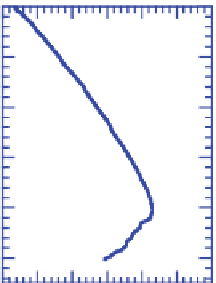Geoscience Reference
In-Depth Information
is stable, but not an inversion. As the layer descends,
both its top and bottom compress and warm adiabat-
ically at the rate of about 10
◦
Ckm
−
1
.Although the
pressure thickness of the layer remains constant during
descension to conserve mass, the height thickness of the
layer decreases with decreasing altitude (due to com-
pression). Thus, at the surface, the pressure thickness
of the layer is still 114 hPa, but the height thickness is 1
km. Figure 6.13 shows that the final temperature profile
in the layer is more stable than is the initial profile. In
fact, the sinking of air created an inversion. Conversely,
the lifting of an unsaturated layer of air decreases the
layer's stability.
Over land at night, air in a large-scale pressure sys-
tem can descend and warm on top of near-surface air
that has been cooled radiatively, creating a combined
radiation/large-scale subsidence inversion. The morn-
ing inversion in Figure 6.12 shows such a case, and the
afternoon profile shows the contribution of the large-
scale subsidence inversion. The subsidence inversion in
Figure 6.12 was due to the Pacific high, well known
for producing large-scale subsidence inversions. Such
inversions are present 85 to 95 percent of the days of
the year in Los Angeles, which is one reason this city
has historically had severe air pollution problems.
Figure 6.12 indicates that the radiation inversion
eroded between morning and afternoon, so that all
that remained was the large-scale subsidence inversion.
Figure 6.14 illustrates this process, showing that, at
03:00, a strong radiation/large-scale subsidence inver-
sion exists. At 06:00, after the sun rises, the ground
and near-surface air heat sufficiently to chip away at
the bottom of the inversion (Figure 6.14a). The chip-
ping continues until late afternoon, when the inversion
base height (mixing depth) reaches a maximum (Figure
6.14b). As the sun goes down, the surface tempera-
ture decreases, and the inversion base height decreases
again. If the ground in Figure 6.14a were heated to
35
◦
Cinstead of 30
◦
Cinlate afternoon, the inversion
would disappear. The elimination of an inversion due
to surface heating is called
popping the inversion
.
Alarge-scale subsidence inversion serves as a lid to
confine pollution beneath it, as shown in Figure 6.15.
The mixing depth in which pollution is trapped is gen-
erally thickest in the late afternoon and thinnest dur-
ing the night and early morning. Mixing ratios of pri-
mary pollutants, such as CO(g), NO(g), primary ROGs,
and primary aerosol particles, usually peak during the
morning, when mixing depths are low and rush-hour
traffic emission rates are high. Although emission rates
are high during afternoon rush hours, afternoon mixing
500
Morgan Hill
8/06/90
600
700
1
5:30 PST
800
900
03:30 PST
1000
260 270 280 290 300 310 320
Temperature (K)
Figure 6.12.
Observed temperature profiles in the
early morning and late afternoon at Morgan Hill,
California, on August 6, 1990. The morning sounding
shows a radiation inversion coupled with a large-scale
subsidence inversion. The afternoon sounding shows
a large-scale subsidence inversion.
sunlight. They do not form regularly over the ocean
because ocean water cools only slightly at night.
6.6.1.5. Large-Scale Subsidence Inversion
A
large-scale subsidence inversion
occurs within
asurface high-pressure system. In such a system,
air descends, compressing and warming adiabatically.
When a layer of air descends adiabatically, the entire
layer becomes more stable, often to the point that an
inversion forms. The descension of air and creation of
an inversion in a high-pressure system both contribute
to near-surface pollution buildup.
Figure 6.13, illustrating the formation of a subsidence
inversion, shows a 1.37-km-thick layer of air based at
3km. At this altitude, the pressure thickness of the layer
is 114 hPa. The initial temperature profile of the layer
5
5
Initial temperature profile
4
4
d
3
3
Final temperature
profile
2
2
d
1
1
0
30
0
-30
-20
-10
0
10
20
Temperature (
o
C)
Figure 6.13.
Formation of a subsidence inversion in
sinking unsaturated air, as described in the text.





















































































































































































Search WWH ::

Custom Search